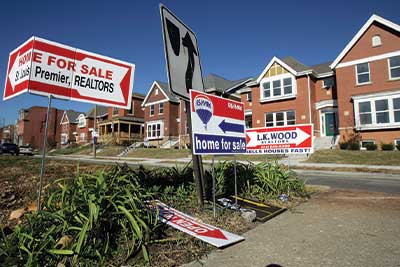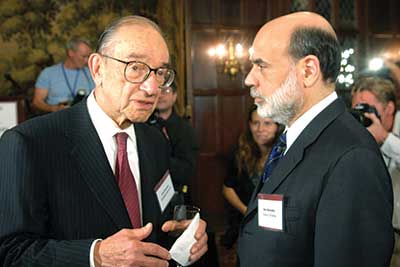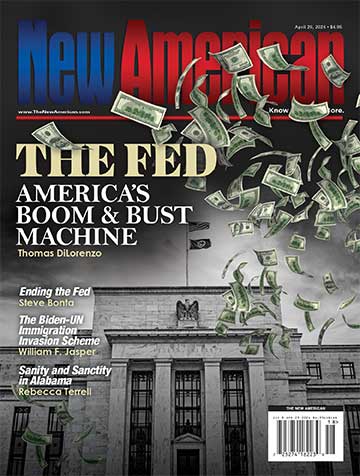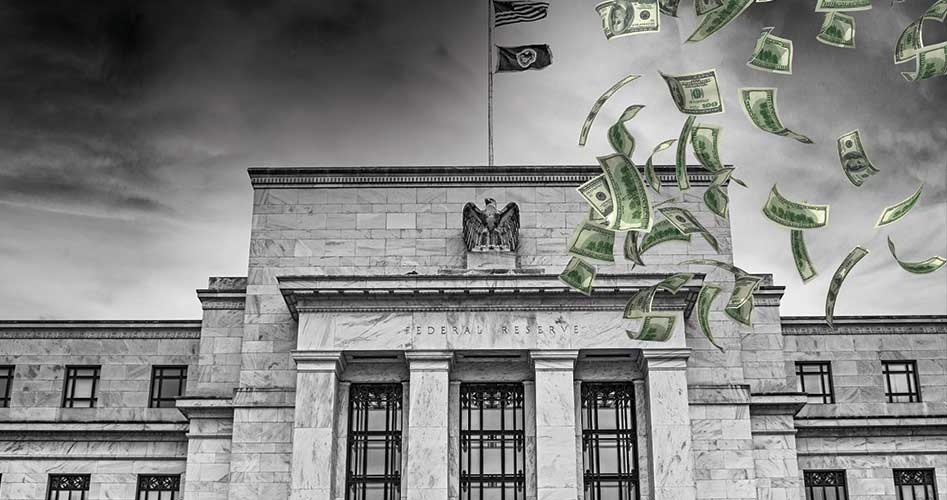The Fed: America’s Boom & Bust Machine
The Federal Reserve Board (“The Fed”), created in 1913, is the U.S. government’s preeminent central-planning vehicle. It exerts control over the supply of money in the economy and regulates almost all aspects of all financial markets. It is essentially a legalized counterfeiting operation and a financial central-planning bureaucracy.
The Fed increases the supply of money in circulation by purchasing billions of dollars of government bonds (“quantitative easing”). It also regulates the “fractional reserve” banking system, whereby banks are required to maintain in reserve only tiny percentages of the loans they make. This percentage is called the “reserve ratio.” At a reserve ratio of say, two percent, a bank with $10 million in reserves can then lend 50 times that amount, or $500 million.
When banks make too many bad loans, the Fed, with help of the U.S. Treasury, frequently bails them out. This is horribly destructive to the American free-market system, which is supposed to be a profit-and-loss system. Profits tell a business that it is serving its customers well; losses say the opposite. With Fed-orchestrated bailouts, however, profits are private but losses are “public,” or paid for by taxpayers one way or another. This encourages even more of the reckless risk-taking that led to the losses in the first place, something that economists call a “moral hazard problem.”
After the real-estate market crash of 2008, the Fed organized the $10 billion bailout of Goldman Sachs, as well as other big banks, and their insurance companies such as AIG ($180 billion). It then increased the overall money supply twice as much in 13 weeks as it had in the previous 100 years! It was that “easy money” policy that pushed interest rates to nearly zero and caused the real-estate bubble in the first place. All Fed-created bubbles eventually burst and cause a bust, or a recession — in this case the “Great Recession” of 2008.
Fed bureaucrats profit personally from creating inflation and boom-and-bust cycles. When they purchase government bonds with “money” created out of thin air (electronically), the interest on the bonds is what is used to pay for the salaries and perks of the Fed bureaucracy. There is a congressional requirement that the Fed return all “excess revenue” over its expenditures to the Treasury, but that creates an incentive for the Fed bureaucracy to spend rather lavishly on itself (large staffs, luxurious offices, private jets, expense accounts, world travel, etc.), so that very little is left over for the Treasury. It is also a built-in incentive to create inflation and boom-and-bust cycles by expanding the money supply too much through bond purchases. The more inflation, the greater the budget of the Fed bureaucracy, and the public be damned. This positive correlation between monetary inflation and spending by the Fed bureaucrats on themselves was even documented in a 1983 research article published in the prestigious American Economic Review by economists William Shughart and Robert Tollison. To Fed bureaucrats, inflation pays — literally.
Former Representative Ron Paul (R-Texas) was met with fierce opposition when he proposed legislation to audit the Fed, which raises the question: If Fed spending is in the “public interest,” why can’t the public see what the Fed is spending money on? Wouldn’t the public like to see what its public servants are doing with their money? Every once in a while, some information does see the light of day, however. In the mid 1990s, a Government Accountability Office investigation revealed that the Fed had more than 25,000 employees, its own air force of 50 Lear Jets and cargo planes, a full-time curator to oversee its massive collection of paintings and sculptures, hundreds of billions of dollars’ worth of assets, and lavish salaries. Even the head janitor at the Fed was paid $163,800 per year plus benefits, and that was nearly 30 years ago.
Boom and bust: Housing market bubbles are but one of many features of the inflationary economy under the Federal Reserve System. (AP Images)

The Fed’s Destabilization Policies
The supposed purpose of the Fed is to “stabilize” the economy by moderating inflation and unemployment, thereby smoothing out the peaks and troughs of the business cycle. It has failed miserably in that task over the past 110 years. Economists Lawrence H. White, George Selgin, and William Lastrapes surveyed 195 scholarly academic journal articles about Fed performance from an historical perspective (published at cato.org). On the subject of price inflation, they concluded that “The Fed has allowed the purchasing power of the U.S. dollar ... to fall dramatically. A consumer basket [of goods and services] selling for $100 in 1790 cost only ... $108 ... in 1913,” the year the Fed was created. But by 2008, the year of the study, the price had soared to $2,422.
The highest rates of inflation in history (1973-1975 and 1978-1980) occurred on the Fed’s watch. Prices also became more unpredictable after the Fed was created, making it harder for businesses (and families) to plan their expenses. Moreover, “the Fed has largely succeeded ... in eliminating deflation.” God forbid that you should pay less for your next car or your next house.
The elimination of deflation by the Fed is based on a gross misunderstanding of economic history. From the end of the Civil War to the turn of the 20th century, the American industrial revolution resulted in a lower consumer price index during that roughly 35-year period. Yes, there was deflation — and it was all a good thing, because it was caused by more production, more jobs, more products invented, and a better standard of living. It also resulted in greater purchasing power for wage earners by increasing their “real wages.” Lower prices for consumers makes every dollar go further.
The current Fed obsession with eliminating deflation and avoiding it at all costs ignores this supply-side explanation of deflation caused by increased production and prosperity, and falsely assumes that all deflation is caused by recessions or depressions and the lower spending levels they entail. It’s Great Depression economics, but we are no longer in the Great Depression. Former Fed Chairman Ben Bernanke was famous for espousing this incorrect view of deflation while championing a policy of always keeping the inflation rate at two percent per year or higher. Thus, the Fed is supposedly a sworn inflation fighter, but its policy is to guarantee inflation!
The above-mentioned authors also found that the U.S. economy was more unstable after the Fed was created than in the previous decades, the opposite of the Fed’s (and the mainstream economic profession’s) proclamations about the Fed supposedly “stabilizing” the economy. A century of evidence is in: The Fed has destabilized the economy far more than it has stabilized it.
Immediately upon its founding in 1913, the Fed created price inflation and a boom-and-bust cycle by doubling the amount of money in circulation between 1914 and 1920. The result was a doubling of the consumer price index in just six years and a depression, the first year of which, 1920, was worse than the first year of the Great Depression a decade later. GDP declined by 24 percent from 1920 to 1921, while the number of Americans unemployed more than doubled, from 2.1 million to 4.9 million.
America might never have entered into World War I if it were not for the Fed, which financed about a fourth of the cost of the war. Fed financing of war — and of all other government programs — creates what some economists call a “fiscal illusion” by which citizens are fooled into thinking that government programs such as war are less expensive than they actually are. Imagine the effect on public support for Ukraine’s war with Russia, for example, if the government announced that for the next round of “military aid” to Ukraine each taxpaying family would be sent a tax bill for $20,000 as their share. One would expect to see far fewer Ukrainian-flag bumper stickers on American cars.
The Great Depression of 1920 was short-lived because the government response was retrenchment. Government spending as a share of GDP fell from 6.5 percent to 3.5 percent during the Harding administration, tax rates were reduced dramatically, and there was massive deregulation of business. The “Roaring ’20s” began to roar economically.
But then the Fed re-inflated the economy in the late 1920s, because that’s what the Fed does — and has always done. It created another bubble in the economy, primarily in the stock market, with a 55-percent increase in the money supply between 1921 and 1929, with thousands of businesses induced to make excessively risky investments thanks to rock-bottom interest rates orchestrated by the Fed. Is this beginning to sound familiar?
For the first time in American history, government responded to a depression (caused by the Fed) with massive government intervention, by Presidents Herbert Hoover and Franklin D. Roosevelt. Up to that point, the standard approach to recessions and depressions was governmental retrenchment, as in the Harding administration. For example, when President Martin Van Buren took office during the 1837 depression, his inaugural address was labeled “A Charter for Inaction.” “All communities are apt to look to government for too much,” he said, and “all former attempts on the part of Government to assume the management of domestic or foreign exchange had proved injurious.” What was needed, he said, was “a system founded on private interest, enterprise, and competition, without the aid of legislative grants or regulations by law.” Federal spending fell during Van Buren’s term by 21 percent, and he lowered tariff rates as well. The 1837 depression ended quickly.
Fast-forward nearly a century, and we had President Hoover intimidating corporations into increasing wages at a time when pay cuts were the only realistic hope of saving jobs. He spent 13 percent of the entire federal budget on government make-work programs and raised myriad taxes to pay for it, draining the private sector of resources and causing more unemployment as a consequence. Hoover started the business of paying farmers to not grow crops and raise livestock — with the intent of increasing farm incomes — creating massive soup-kitchen lines and punishing American consumers with shortages and higher food prices. He signed the 1930 Smoot-Hawley Tariff Act that instigated an international trade war as other countries retaliated with punitive tariffs on American products. The volume of international trade shrank by two-thirds in three years, worsening the Great Depression.
FDR’s “New Deal” was not really new, but a great expansion of Hoover’s already-massive government intervention. That, along with the introduction of new Social Security and unemployment insurance taxes and minimum-wage laws, made it even more expensive for American businesses to hire people. The result was not a one-year depression, as in 1837 and 1920, but a 15-year Great Depression that did not really end until World War II was over, the Army was largely demobilized, and the federal budget was subsequently reduced by two-thirds from 1945 to 1947.
More recently, after creating the “dotcom” bubble that burst in 2000, the Fed responded to the bursting of the bubble that it had created in the same way that it always does — by doubling down, and more, on even more money creation. The Fed under Alan Greenspan created more money between 2001 and 2007 than had previously been created in the entire history of the United States since 1776! An overwhelming amount of this money fueled the housing market, with interest rates once again pushed to historically low levels as part of the federal government’s policy of increasing “affordable housing” for minorities and lower-income home purchasers.

Moneymakers: Former Fed chairmen Alan Greenspan (left) and Ben Bernanke. These two men presided over the largest monetary expansion in American history, a bubble that burst in the calamitous Great Recession. (AP Images)
The Fed did its part to encourage such “affordable housing” by having the Federal Reserve Bank of Boston publish a guidebook on lending titled “Closing the Gap: A Guide to Equal Opportunity Housing.” Under the threat of being fined very heavily — or sued — for lending discrimination, mortgage lenders were instructed to use “new standards” for mortgage lending for minority and lower-income customers. They were told to abandon “traditional underwriting standards” such as proof of income, ratio of mortgage payments to monthly income, and credit history when dealing with “minority and low income” applicants who were labeled “sub-prime borrowers.” “Credit counseling” was said to be an adequate substitute for a fair or good credit rating for minority and lower-income home-loan applicants.
So that mortgage lenders would not just ignore this guarantee-to-lose-money advice, the Fed assured them that they could immediately sell their bad loans to the “quasi-governmental organizations” Freddie Mac (the Federal Home Loan Mortgage Corporation) and Fannie Mae (the Federal National Mortgage Association), and so they did. Their theory was apparently that if, say, giving 1,000 bad loans to unqualified borrowers was grossly unprofitable, it would somehow become profitable if bundled together and sold as a “security.” The result of all of this was the “Great Recession” of 2008, the worst economic downturn since the Great Depression of the 1930s. After the bust, Freddie and Fannie were bailed out with tens of billions of dollars supplied by the Fed and the U.S. Treasury.
As economically destructive as Fed-orchestrated bailouts are to what’s left of the American free-enterprise system, its current obsession with controlling interest rates is just as bad. Any college freshman who takes an introductory economics course is taught that price controls have myriad negative effects, and have had for literally thousands of years. Price ceilings cause shortages; price floors cause surpluses. Price controls deter investment because of the uncertainty involved in guessing what politicians will declare an acceptable price to be. Shortages breed bribery as a means of acquiring the short supply of goods, which always ends up benefiting the more-affluent at the expense of the less-affluent. Price controls cause economic chaos, because they are based not on the economic realities of supply and demand but on the whims of politicians and bureaucrats.
Nevertheless, the thousands of economists employed by the Fed support its policy of price controls when it comes to the price of borrowing — the rate of interest. The Fed panders to the beneficiaries of low interest rates, such as the real-estate industry and its banking-industry partners, while inflicting great harm on the elderly and others who earn little or nothing on their savings or are forced to assume excessive risk by investing in stocks. It induces people to spend more and save less, which is not always the best personal financial advice, and it comes from an organization — the Fed — that touts itself as an expert in personal financial advice.
Private savings is an important source of investment capital that is necessary to fuel economic growth, so the reduction of savings caused by the Fed’s low/zero interest-rate policies slows economic growth, destroying jobs and making ordinary working Americans worse off. Less capital investment means less technology and technological upgrading, which makes it harder for American corporations to compete internationally.
The Fed’s Academic Praetorian Guard
The Fed employs an army of academics who essentially serve as its publicists and propagandists. Professor Lawrence H. White published a 2005 article at Econ Journal Watch, an online academic journal, in which he noted that the Fed directly employed 495 full-time economists at the time, engaged 120 “leading academic economists” as paid consultants or visiting scholars, and brought more than 300 academic economists to its conferences each year. (Economist Murray N. Rothbard once quipped that your average academic monetary economist “would stab his mother to death with a fork for an invitation to a Fed conference”!)
The result of all this, Professor White found, was that 74 percent of all academic journal articles on monetary policy published in America were either in the Fed’s own journals or co-authored by Fed economists. He summarized the effects of this with a quote from Milton Friedman: “If you want to advance in the field of monetary research ... you would be disinclined to criticize the major employer in the field.”
This is nothing new. From 1948 until the mid-1980s, the bestselling economics textbook in the world was Paul Samuelson’s Economics. Generations of economics students were taught by Samuelson’s text; most other texts were clones of his book. In it, Samuelson described the Fed as an institution run by angels or saints with the brains of Einstein and the magic touch of the Wizard of Oz. Here’s how Samuelson described the Fed’s functions:
The Federal Reserve’s goals are steady growth in national output and low unemployment. Its sworn enemy is inflation. If aggregate demand is excessive, so that prices are being bid up, the Federal Reserve Board may want to slow the money supply, thereby slowing aggregate demand and output growth. If unemployment is high and business languishing, the Fed may consider increasing the money supply, thereby raising aggregate demand and augmenting output growth. In a nutshell, this is the function of central banking, which is an essential part of macroeconomic management.
Even more comical is how Washington Post writer Bob Woodward compared former Fed Chairman Alan Greenspan to the maestro of an orchestra, smoothly waving his baton to guide economic prosperity. That’s how the Washington establishment thinks of itself: in charge of orchestrating the entire world. The book is entitled Maestro: Greenspan’s Fed and the American Boom.
The Central-planning Fed
Academic economists are not the only excuse-makers and propagandists for the Fed. Various “celebrity” authors and TV talking heads play their part as well. After the crash of 2008, The Wall Street Journal featured an October 10, 2008 article by business historian John Steele Gordon in which he blamed the crash on “the baleful influence of Thomas Jefferson”! Jefferson opposed the creation of the national bank controlled by politicians that was proposed by his political nemesis, Alexander Hamilton. He once called the Bank of the United States, the 19th-century precursor to the Fed, a “permanent engine of corruption.”
Jefferson’s contemporary political heirs, most notably Congressman Ron Paul, in Gordon’s view, are responsible for the crash by being too critical of the Fed. The crash was caused because the Fed had too little central-planning authority, according to Gordon.
Then there was stockbroker Henry Kaufman writing in the Financial Times that the Greenspan Fed was too “libertarian” because Alan Greenspan had been a protégé of Ayn Rand’s some 40 years earlier. In reality, in addition to the Fed’s never-ending generation of price inflation and boom-and-bust cycles with its monetary policies, it centrally plans virtually all aspects of all financial markets with layer upon layer of bureaucracy. An annual Fed publication entitled The Federal Reserve System: Purposes & Functions boasts of its “supervisory and regulatory authority over a wide range of financial institutions.” This includes, but is not limited to:
Bank holding companies, state-chartered banks, foreign branches of member banks, edge and agreement corporations, U.S. state-licensed branches, agencies, and representative offices of foreign banks, national banks, savings banks, nonbank subsidiaries of bank holding companies, thrift holding companies, financial reporting procedures, accounting policies of banks, business continuity in case of emergencies, consumer protection laws, securities dealings of banks, information technology used by banks, foreign investment by banks, foreign lending by banks, branch banking, bank mergers and acquisitions, who may own a bank, capital adequacy standards, extensions of credit for the purchase of securities, equal opportunity lending, mortgage disclosure information, electronic funds transfers, interbank liabilities, Community Reinvestment Act sub-prime lending demands, all international banking operations, consumer leasing, privacy of consumer financial information, payments on demand deposits, fair credit reporting, transactions between member banks and their affiliates, truth in lending, truth in savings.
This is not very “libertarian,” which is why the most famous libertarian American political figure, Congressman Ron Paul, was the Fed’s sharpest critic.
The “Woke” Fed
In a fall 2022 article in The Independent Review by Emre Kuvvet entitled “Political Affiliations of Federal Reserve Economists,” the author describes how more and more Fed research and publication has nothing to do with monetary policy. All the rage among Fed researchers are articles about climate change, racism, “inequity,” gender discrimination, and Diversity, Equity, and Inclusion (DEI).
Although economics departments have historically been among the more conservative areas of universities, Kuvvet found that the ratio of Democrats to Republicans in American university economics departments is 4.5:1. (In the humanities and social sciences it’s more like 100:1, or even 1,000:1 at larger universities). It is orders of magnitude more biased in favor of Democrats at the Fed. At the Board of Governors of the Federal Reserve System, there were 97 Democrats and two Republicans, for a 48.5:1 ratio. Under the category of “Leadership Positions,” there were 45 Democrats and one Republican; Democratic Fed economists outnumbered their Republican counterparts 61 to three; and there were 55 Democratic female Fed economists and only two Republican female economists.
Like every other Washington, D.C., bureaucracy, the Fed is an increasingly radical, left-wing, “woke” enclave that is essentially accountable to no one, not even Congress. It is the ultimate Deep State tool, and always will be as long as it exists.



